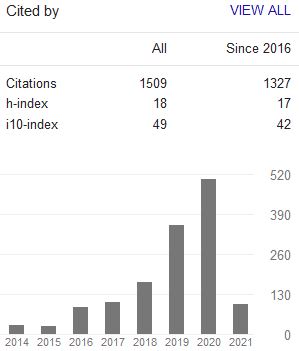SUFISM AND VIRTUAL PIETY: A Narration of the Millennial Murshid in North Sumatra
Abstract
Keywords
Full Text:
PDFReferences
Alatas, I. F, “Sufi Sociality in Social Mediaâ€, Carla Jones and Martin Slama, ed., Pious, Celebrity, Sociality: A Forum on Islam and Social Media in Southeast Asia, American Ethnologist, 2017.
Becci, I. and Monnot, C. “Spiritualité et Religion: Nouveaux Carburants vers la Transition Energétique?â€, Histoire, Monde et Culture Religieuses 40, 4 (2016).
Bruinessen, M. v. “Sufism, Popular Islam and the Encounter with Modernityâ€, Muhammad Khalid Masud, ed., Islam and Modernity: Key Issues and Debates, Edinburgh: Edinburgh University Press, 2009.
Chih, R., “Sainteté, Maître Spirituelle et Patronage: Les Fondements de l’Autorité dans le Soufismeâ€, Archives de Sciences Sociales des Religions 49, 125 (2004).
Coman, L. A. and Coman, M. “Religion, Popular Culture and Social Media: The Construction of A Religious Leader Image on Facebookâ€, Journal for Communication Studies 10, 2 (2017).
Dahnhardt, T. Change and Continuity in Indian Sufism: A Naqshbandi-Mujaddidi Branch in the Hindu Environment, New Delhi: D.K. Printworld, 2002.
Dudoignon, S.A. “A Surrogate Aristocracy? Sufi Adab, Modernity, Rurality and Civilization in Ex-Soviet Central Asiaâ€, Catherine Mayeur-Jaouen, ed., Adab and Modernity: “A Civilising Processâ€? Sixteenth-Twenty-First Century, Leiden: Brill, 2019
Epstein, J. “Introduction: Generation X, Youth Culture and Identityâ€, Jonathon Epstein, ed., Youth Culture: Identity in a Postmodern World. Oxford: Blackwell, 1998.
Geoffroy, E. Le Soufisme: Histoire, Fondements et Pratiques de l’Islam Spirituel. Eyrolles, 2019.
Gilsenan, M. Connaissance de l’Islam, Paris: Karthala, 2001.
Haddad, M. “Zawiya Réelle, Zawiya Virtuelle: Soufisme, Francophonie et Nouvelles Technologies ou Quebecâ€, Globe: Revue Internationale d'Etudes Québécoises 11, 1 (2018).
Hanieh, H.A. Sufism and Sufi Orders: God’s Spiritual Paths Adaptation and Renewal in the Context of Modernization, Amman: Friedrich-Ebert-Stiftung, 2011.
Hidayat, Z. “Legitimasi Politik di Makam Tuan Guru: Perilaku Ziarah Politisi Lokal ke Tarekat Naqsyabandiyah Babussalam (TNB)â€, Jurnal al-Tafkir 7, 1 (2014).
Hidayat, Z. “Kekuasaan Spiritual dalam Kerajaan Tuhan: Struktur Sosial dan Otoritas Mursyid dalam Tarekat Naqsyabandiyah-Khalidiyah Babussalam (TNKB)â€, Jurnal Medan Agama 2, 1 (2015).
Hidayat, Z. “Peran Sufi Batak dalam Persaudaraan Lintas Iman di Tanah Batak: Studi Kasus Tarekat Naqsyabandiyah-Khalidiyah Serambi Babussalam (TNKSB)â€, Jurnal Akademika 21, 2 (2016).
Hidayat, Z. Kuasa Kelas Bawah dan Bisnis Berkah di Makam Wali: Narasi Kehidupan Khadim Tarekat, Ciputat: Pustakapedia, 2019.
Hidayat, Z. and Syahrul, M. “Indonesian Sufi in Malay World: A Preliminary Exploration with Reference to Tariqa Naqshabandiyya-Khalidiyya Babussalam (TNKB)â€, Journal of Indonesian Islam 11, 1 (2017),.
Hill, J. “Sufism between Past and Modernityâ€, Mark Woodward and Ronald Lukens-Bull, ed., Handbook of Contemporary Islam and Muslim Lives, Netherland: Springer International Publishing, 2018.
Hoover, S.M. Religion in the Media Age. London: Routledge, 2016.
Howell, J. “Sufism on the Silver Screen: Indonesian Innovations in Islamic Televangelis.†Journal of Indonesian Islam 2, 2 (2008).
Husein, F. and Slama M. “Online Pious and it’s Discontent: Revitising Islamic Anxieties on Indonesian Social Mediaâ€, Indonesia and the Malay World 46, 134 (2018).
Laffan, M. “From Alternative Medicine to National Cure: Another Voice for the Sufi Orders in the Indonesian Mediaâ€, Archives de Sciences Sociales des Religions 135 (2006).
Makhasin, L. “Urban Sufism, Media and Religious Change in Indonesiaâ€, Ijtima‘iyya: Journal of Muslim Society Research 1, 1 (2016).
McClure, P.K. “Faith and Facebook in a Pluralistic Age: The Effects of Social Networking Sites on the Religious Beliefs of Emerging Adultsâ€. Sociological Perspectives 4, 59 (2016).
Milani, M. et.al. “Branding of Spiritual Authenticity and Nationalism in Transnational Sufismâ€, Patrick Michel, et.al., ed., Religions, Nations and Transnationalism in Multiple Modernities. New York: Palgrave Macmillan, 2017.
Muedini, F. Sponsoring Sufism: How Governments Promote “Mystical Islam†in Their Domestic and Foreign Policies. New York: Palgrave Macmillan, 2015.
Pinto, P.G. “Mystical Metaphors: Ritual, Symbols and Self in Syrian Sufism.†Culture and Religion 18, 2 (2017).
Piraini, F. “Between Real and Virtual Communities Sufism in Western Societies and the Naqshabandi Haqqani Case.†Social Compass 63, 1 (2016).
Piraino, F. “Les Politiques du Soufisme en France: Le Cas de La Qadiriyya Budshishiyya.†Social Compas 66, 1 (2019).
Salvatore, A. “Sufi Articulations of Civility, Globality and Soverigntry.†Journal of Religious and Political Practice 4, 2 (2018).
Saramifar, Y. “Crafting Sacrality from the Tensile Life of Objects Learning about the Material Life Prayer Beads from A Khaksari Sufi Murshid.†Contemporary Islam 12 (2018).
Sardana, D. et.al. “Spirituality and Religiosity at the Junctiong of Consumerism: Exploring Consumer Preference for Spiritual Brands.†International Journal of Consumer Studies 42, 6 (2018).
Sedgwick, M. “Sufi Religious Leaders and Sufi Orders in the Contemporary Middle East.†Sociology of Islam 6, 2 (2018).
Slama, M. “Practising Islam through Social Media in Indonesiaâ€, Indonesia and Malay World 46, 134 (2018).
Weismann, I. “Sufism in the Age of Globalizationâ€, Lloyd Ridgeon, ed., The Cambridge Companion to Sufism, New York: Cambridge University Press, 2015.
Yusdani, et.al. “Yogyakarta Urban Middle-Class Sufism: Economic, Political, and Cultural Networks.†Ulumuna: Journal of Islamic Studies 23, 2 (2019).
Zarcone, T. “l’Habit de Syomboles des Derviches Tourneurs.†Journal of the History of Sufism 6 (2015).
DOI: 10.15642/JIIS.2022.16.1.133-152
Refbacks
- There are currently no refbacks.
Indexed by:
Journal of Indonesian Islam (ISSN 1978-6301 and E-ISSN 2355-6994) is published by the Postgraduate Program (PPs) and the Institute for the Study of Religion and Society (LSAS), State Islamic University (UIN) of Sunan Ampel Surabaya.
Journal of Indonesian Islam by http://jiis.uinsby.ac.id/index.php/JIIs/index is licensed under a Creative Commons Attribution-ShareAlike 4.0 International License.
Copyright ©2020 State Islamic University (UIN) of Sunan Ampel Surabaya. Powered by Public Knowledge Project OJS.







